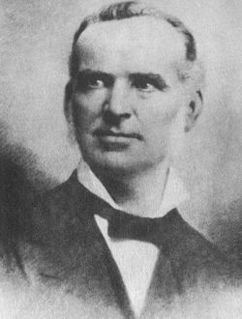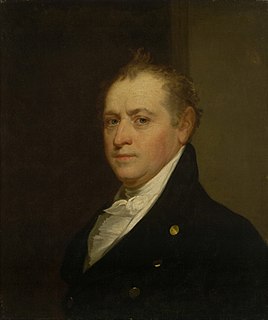Related Research Articles

The Federalist Party was a conservative political party which was the first political party in the United States. As such, under Alexander Hamilton, it dominated the national government from 1789 to 1801. Defeated by the Jeffersonian Republicans in 1800, it became a minority party while keeping its stronghold in New England and made a brief resurgence by opposing the War of 1812. It then collapsed with its last presidential candidate in 1816. Remnants lasted for a few years afterwards. The party appealed to businesses and to conservatives who favored banks, national over state government, manufacturing, an army and navy, and in world affairs preferred Great Britain and strongly opposed the French Revolution. The party favored centralization, federalism, modernization, industrialization and protectionism.
The U.S. state of Connecticut began as three distinct settlements of Puritans from Massachusetts and England; they combined under a single royal charter in 1663. Known as the "land of steady habits" for its political, social and religious conservatism, the colony prospered from the trade and farming of its ethnic English Protestant population. The Congregational and Unitarian churches became prominent here. Connecticut played an active role in the American Revolution, and became a bastion of the conservative, business-oriented, Constitutionalism Federalist Party.

Jared Ingersoll was an American Founding Father, lawyer, and statesman from Philadelphia, Pennsylvania. He was a delegate to the Continental Congress and a signer of the United States Constitution. He served as DeWitt Clinton's running mate in the 1812 election, but Clinton and Ingersoll were defeated by James Madison and Elbridge Gerry.

The Hartford Convention was a series of meetings from December 15, 1814 to January 5, 1815, in Hartford, Connecticut, United States, in which the New England Federalist Party met to discuss their grievances concerning the ongoing War of 1812 and the political problems arising from the federal government's increasing power.

Charles Miller Croswell was the 17th Governor of Michigan from 1877 to 1881.

The following is a list of lieutenant governors of the State of Connecticut.

The First Party System is a model of American politics used in history and political science to periodize the political party system that existed in the United States between roughly 1792 and 1824. It featured two national parties competing for control of the presidency, Congress, and the states: the Federalist Party, created largely by Alexander Hamilton, and the rival Jeffersonian Democratic-Republican Party, formed by Thomas Jefferson and James Madison, usually called at the time the Republican Party. The Federalists were dominant until 1800, while the Republicans were dominant after 1800. Both parties originated in national politics, but soon expanded their efforts to gain supporters and voters in every state. The Federalists appealed to the business community and the Republicans to the planters and farmers. By 1796, politics in every state was nearly monopolized by the two parties, with party newspapers and caucuses becoming effective tools to mobilize voters.

Alexander Wolcott was a United States politician, customs inspector, and nominee to the Supreme Court of the United States. Nominated by James Madison in 1811, to replace the late William Cushing, he was rejected by the United States Senate by a vote of 9–24. He was later a delegate to the 1818 convention that drafted the Constitution of Connecticut.
Connecticut is known as "The Constitution State". The origin of this title is uncertain, but the nickname is assumed to be a reference to the Fundamental Orders of 1638–39 which represent the framework for the first formal government written by a representative body in Connecticut. Connecticut's government has operated under the direction of five separate documents in its history. The Connecticut Colony at Hartford was governed by the Fundamental Orders, and the Quinnipiac Colony at New Haven had its own Constitution in The Fundamental Agreement of the New Haven Colony which was signed on June 4, 1639.
The 1806 and 1807 United States Senate elections were elections that had the Democratic-Republican Party increase its overwhelming control of the Senate by one additional Senator. The Federalists went into the elections with such a small share of Senate seats that even if they had won every election, they would still have remained a minority caucus. As it was, however, they lost one of the two seats they were defending and picked up no gains from their opponents.

Trinity Church on the Green or Trinity on the Green is a historic, culturally and community-active parish of the Episcopal Diocese of Connecticut in New Haven, Connecticut of the Episcopal Church. It is one of three historic churches on the New Haven Green.

Harry Croswell was a crusading political journalist, a publisher, author, and an Episcopal Church clergyman. Though largely self-educated, he received an honorary degree of A. M. from Yale College in 1817, an honorary Doctorate of Divinity from Trinity College, Hartford, Connecticut in 1831 – an institution he co-founded – established the first public lectures in New Haven, and founded an evening school for the education of adult African-Americans in the city. He was a key figure in first amendment battles over freedom of the press and religious freedom. After abandoning politics for religion, he became the much respected Rector of Trinity Church on the Green in New Haven, Connecticut, for forty-three years, growing his church and establishing seven new churches within the original limits of his parish. Though he published fourteen books, and wrote newspaper articles as an editor and journalist weekly for eleven years, he is best known as an author for being the first person to define the word cocktail in print.

The 1826 Connecticut gubernatorial election was held on April 13, 1826. Incumbent governor and Toleration Party candidate Oliver Wolcott Jr. defeated former senator and Federalist Party candidate David Daggett, winning with 56.77% of the vote.

The 1825 Connecticut gubernatorial election was held on April 14, 1825. Incumbent governor and Toleration Party candidate Oliver Wolcott Jr. defeated Federalist Party candidates former senator David Daggett, former delegate Nathan Smith and former congressman Timothy Pitkin, winning with 68.82% of the vote.

The 1824 Connecticut gubernatorial election was held on April 8, 1824. Incumbent governor and Toleration Party candidate Oliver Wolcott Jr. defeated former congressman and Federalist Party candidate Timothy Pitkin, winning with 88.81% of the vote.

The 1823 Connecticut gubernatorial election was held on April 10, 1823. Incumbent governor and Toleration Party candidate Oliver Wolcott Jr. won re-election with 88.96% of the vote.

The 1822 Connecticut gubernatorial election was held on April 11, 1822. Incumbent governor and Toleration Party candidate Oliver Wolcott Jr. defeated former congressman and Federalist Party candidate Zephaniah Swift, winning with 86.59% of the vote.

The 1820 Connecticut gubernatorial election was held on April 13, 1820. Incumbent governor and Toleration Party candidate Oliver Wolcott Jr. was re-elected, defeating Federalist Party candidates former delegate Nathan Smith and former congressman and state legislator Timothy Pitkin with 76.14% of the vote.

The 1819 Connecticut gubernatorial election was held on April 8, 1819. Incumbent governor and Toleration Party candidate Oliver Wolcott Jr. was re-elected, winning with 86.85% of the vote.

The 1818 Connecticut gubernatorial election was held on April 9, 1818. Incumbent governor and Toleration Party candidate Oliver Wolcott Jr. was re-elected, defeating congressman and Federalist Party candidate Timothy Pitkin with 86.32% of the vote.
References
- ↑ Purcell, Richard J. Connecticut in Transition: 1775-1818. Wesleyan University Press, Middletown, Connecticut, 1963, p. 332
- ↑ Green, Maria Louise. The development of religious liberty in Connecticut, Houghton, Mifflin, 1905, p. 443
- ↑ Purcell, Richard J. Connecticut in Transition: 1775-1818. Wesleyan University Press, Middletown, Connecticut, 1963, p. 348
- ↑ Olsen, Neil C. The End of Theocracy in America: The Distinguishing Line of Harry Croswell's Election Sermon, "including a transcription of A Sermon Preached at the Anniversary Election, Hartford, May 14, 1818 by the Rev. Harry Croswell, A.M., Rector of Trinity Church, New Haven." Nonagram Publications, ISBN 978-1478365464, 2013, chapter 3
- ↑ Horton, Wesley. The Connecticut state constitution: a reference guide. Greenwood Publishing Group, 1993, p. 11
- ↑ Olsen, p. 33
